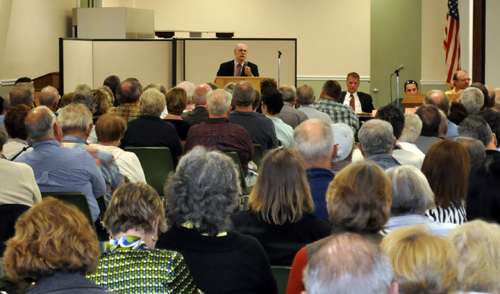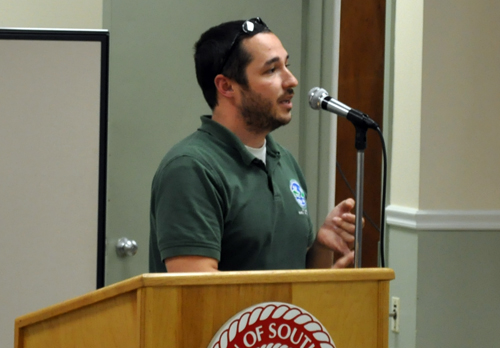Southold: Clear out so we can better hunt deer

In the closing moments of Thursday night’s Southold Town Deer Forum at the Peconic recreation center, a member of the audience pointed a finger at Supervisor Scott Russell and asked what the town’s going to do about the deer population.
The supervisor, echoing the sentiment of many of the approximately 250 residents in the room, said he believes there’s one obvious direction for the town to head in.
“We need to focus on culling the herd,” Mr. Russell said. “And easing the restrictions on hunters. We have to take each year far more deer than are being reproduced.”
Most of the audience and each of the 13 members of Thursday evening’s panel — which featured elected officials and representatives of the science, hunting and conservation communities — agreed hunting is the best way to control the overpopulation of deer on the North Fork. It’s a welcome transformation for Mr. Russell in a town where that wasn’t always the case.
“Twenty years ago if we were at a meeting talking about hunting on town lands, [the community would] be coming at us with pitchforks,” the supervisor said after the 2 1/2 hour forum concluded. “Today, they’re saying we’re still not doing enough. The public health crisis has a lot to do with that.”
Statistics released recently by the State Department of Health show Suffolk holds 49 percent of the state’s babesiosis cases and 44 percent of Ehrlichiosis cases. But while an increase in reported incidents of tickborne illness in Suffolk County and Southold Town has raised the volume on the need to control the deer population, many of Thursday night’s speakers said state regulations will have to be modified for any real progress to be made.
Specific suggestions included reducing the 500-foot legal distance bow hunters must be from a dwelling, allowing the use of crossbows, lengthening the hunting season in Suffolk County and expanding nuisance permit programs.
Mr. Russell even suggested the state give Southold Town the authority to issue and control its own deer permits.
However this season, the DEC did implement one change to cut down on the number of does in the field in Suffolk County, to limit reproduction of further deer: rather than receiving a bonus permit for either sex, hunters can only get an antlerless bonus permit.
About 3,500 of the 35,000 deer in Suffolk County live in Southold Town, said Joshua Stiller, a wildlife biologist with the New York State Department of Environmental Conservation. Only about 2,600 to 3,000 deer have been harvested across the county in each of the past three years, he said. A total of 598 deer have been killed through Southold Town’s deer management program since it began in 2008, including 212 a year ago.
Even the DEC says that’s not enough.
“Harvesting 2,600 deer is far off from what we need to do to stabilize or decrease the population,” Mr. Stiller said. “Our current numbers are woefully insufficient.”
The major roadblock to improving these numbers is in state laws the DEC can’t control, Mr. Stiller said.
“It’s all set through legislation,” he said of hunting regulations the DEC must enforce. “We have very little that we can do about our regulatory control.”

One name repeated throughout the forum was that of Assemblyman Robert Sweeney (D-Lindenhurst), who was blamed repeatedly for allowing legislation that would relax hunting regulations in Suffolk County and across the state to stall in the Assembly’s Environmental Conservation Committee, which he chairs.
“We’ve been trying to get some of the restrictions relaxed for hunters to have better access to control the population,” Mr. Gergela said. “But for whatever reason we have not been able to get statutory changes through the state Assembly. The chair of the committee is Bob Sweeney from Lindenhurst and we have still not been able to improve the regulations so the DEC, hunters and others can better manage the population in Suffolk County.”
While holding out hope legislation can move forward in Albany, Mr. Gergela said his organization has plans of its own to help reduce the deer population on the East End.
While last year the Farm Bureau secured nearly $1 million earmarked by Senator Ken LaValle (R-Port Jefferson) for deer fencing to protect local crops, Mr. Gergela said this year his organization has $200,000 it will contribute to expanding wildlife sharpshooting efforts on the East End through the United States Department of Agriculture — a service Southold Town has utilized in recent years. He is asking the five East End towns to contribute an additional $25,000 each toward the program, something Mr. Russell said he will ask the Town Board to support.
While it was clear from the audience reaction that most in attendance Thursday agreed that changes to state law is the best immediate course of action toward controlling the deer population, it wasn’t unanimous.
One local farmer who came forward during the community response portion of the forum to express his concern over the idea of relaxing hunting regulations was Tom Wickham of Wickham’s Fruit Farm in Cutchogue. He said that while he’s had success protecting his crops through the DEC-controlled nuisance permit program, he worries how much people’s safety would be put at risk if less skilled hunters were given more access through reduced restrictions. He said he understands people’s concerns over the deer population’s impact on motor vehicle safety and the spread of tick-borne illnesses, but wonders if relaxed controls would have far worse consequences.
“What is going to happen when someone gets shot?” he asked.
Other residents to speak out Thursday included several political candidates and members of the newly formed North Fork Deer Management Alliance, which is promoting action targeted at reducing deer populations and going door-to-door to collect signatures in support of this effort.
After the last of more than 20 residents spoke Thursday, Mr. Russell said he was encouraged by the information exchanged at the forum, and the response of the community.
“Southold Town needs to take the deer crisis and make it priority number one,” he said. “The one gentlemen at the end, he may have been a little angry, but he was right. We need to raise the level of attention this issue gets.”








